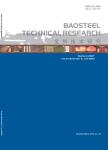Study on the friction and wear properties of the surface nanocrystallized 1.0C-1.5Cr steel induced by the surface mechanical attrition treatment
Study on the friction and wear properties of the surface nanocrystallized 1.0C-1.5Cr steel induced by the surface mechanical attrition treatment作者机构:Advanced Technology DivisionResearch InstituteBaoshan Iron & Steel Co. Ltd. Shanghai 201900 China Advanced Technology DivisionResearch InstituteBaoshan Iron & Steel Co. Ltd. Shanghai 201900 China School of Materials Science & EngineeringShanghai Jiao Tong University Shanghai 200030 China
出 版 物:《Baosteel Technical Research》 (宝钢技术研究(英文版))
年 卷 期:2010年第4卷第4期
页 面:17-21页
学科分类:080503[工学-材料加工工程] 08[工学] 0805[工学-材料科学与工程(可授工学、理学学位)] 0802[工学-机械工程] 080201[工学-机械制造及其自动化]
基 金:supported by the National High-Tech.R&D Program of China(the National 863 plans projects Grant No.2007AA03Z352)
主 题:1.0C-1.5Cr steels surface mechanical attrition treatment surface nanocrystallization friction and wear
摘 要:Nano-structured layers are fabricated on the surface of 1.0C-1.5Cr steel by using the surface mechanical attrition treatment(SMAT)technology,and the microstructures of the surface nano-crystallization layers are characterized by means of X-ray diffraction(XRD)and transmission electron microscopy(TEM).The friction and wear properties are also investigated by a UMT-2 friction and wear *** research has indicated that the average diameter of nanocrystalline grains in the surface layer after being treated for 15 min is in the range of 10-20 nm,and ferrite and cementite grains can not be identified by their *** wear-resistance of the specimen treated for 15 min has been doubled,compared with that of the matrix due to the grain refinement to a nano-sized *** lowest friction coefficient is 0.27,which is for the specimen treated for 30 min,resulting from the dissolution of the cementite phase and the formation of a relative homogenous *** SMAT technique for enhancing the wear-resistance of the 1.0C-1.5Cr steel has an optimum processing time,which is in the range of 15-30 *** dominant wear mechanism of the specimen treated for 15 min changes from adhesive wear into particle wear.



